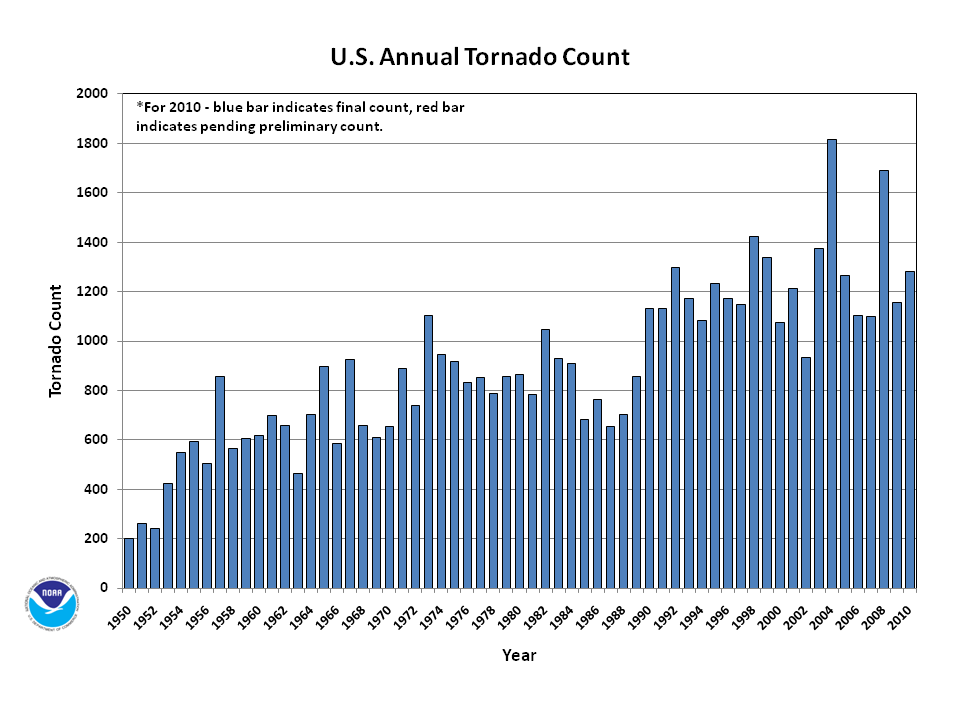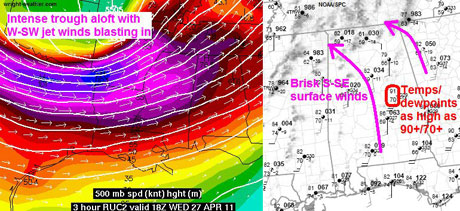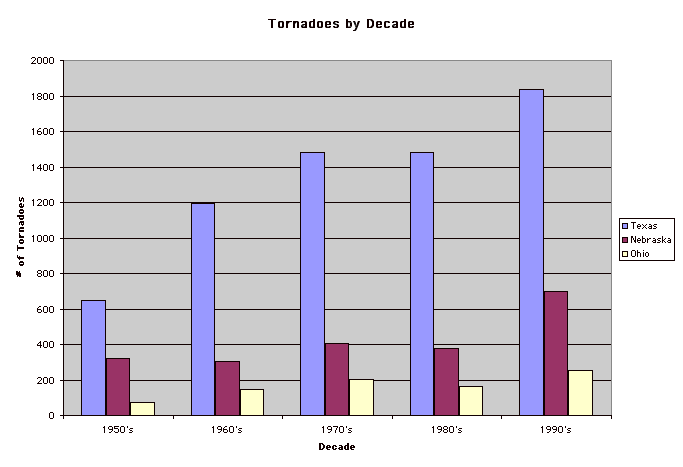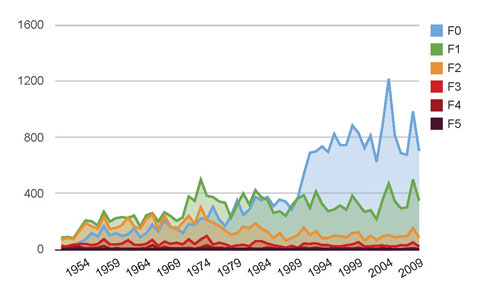UPDATE: It is unfortunate that NYT blogger Andy Revkin has chosen to inappropriately shorten and then take out of context the nuanced statements of a number of actual scientific experts, like Trenberth (cited bel0w). Ironically, Revkin supports a too-little, too-late energy technology development strategy can’t possibly avert catastrophic global warming — nor can it generate funds needed for adaptation. So it is hypocritical of him to attack others for not constantly saying how much we need to improve housing for those in tornado alley. Obviously we do, and that’s a great thing for blogs that don’t focus on climate to write about. Just as obviously we need an aggressive strategy for reducing GHGs that also supports real adaptation.
Revkin’s argument that we shouldn’t talk about the impact of global warming on extreme weather if we don’t propose efforts to reduce the devastation caused by extreme weather today would be like saying we shouldn’t talk about the impact of global warming on the poor unless we propose solutions to poverty today. It the Bjorn Lomborg two-step.
Stu Ostro, Weather Channel Senior Meteorologist, “The Katrina of tornado outbreaks“:
The atmosphere was explosively unstable with summerlike heat and humidity, interacting with a classic wind shear setup as a strong jet stream and upper-level trough crashed overhead….
The atmosphere is extraordinarily complex, and ultimately what’s happened the past month is probably a combination of influences, including La Nina, other natural variability, and anthropogenic global warming.
UPDATE: “Persistent, heavy rains have helped swell the Mississippi and Ohio rivers to the highest levels ever recorded,” CNN reports. And the rivers are still rising.
The Effect of Climate Change on Tornado Frequency and Magnitude: “There is an obvious increase in tornado frequency between 1950-1999. This could be due to increased detection. Also this could be due to changing climatic conditions.”
For decades, scientists have predicted that if we kept pouring increasing amounts of heat-trapping greenhouse gases into the atmosphere, we would change the climate. They specifically predicted that that many key aspects of the weather would become more extreme — more extreme heat waves, more intense droughts, and stronger deluges.
As far back as 1995, analysis by NOAA’s National Climatic Data Center (led by Tom Karl) showed that over the course of the 20th century, the United States had suffered a statistically significant increase in a variety of extreme weather events, the very ones you would expect from global warming, such as more — and more intense — precipitation. That analysis concluded the chances were only “5 to 10 percent” this increase was due to factors other than global warming, such as “natural climate variability.” And since 1995, the climate has gotten measurably more extreme.
Multiple scientific studies find that indeed the weather has become more extreme, as expected, and that it is extremely likely that humans are a contributing cause (see “Two seminal Nature papers join growing body of evidence that human emissions fuel extreme weather, flooding that harm humans and the environment” and links therein).
Beyond that, as Dr. Kevin Trenberth, head of the Climate Analysis Section of the National Center for Atmospheric Research, explained here last year: “There is a systematic influence on all of these weather events now-a-days because of the fact that there is this extra water vapor lurking around in the atmosphere than there used to be say 30 years ago. It’s about a 4% extra amount, it invigorates the storms, it provides plenty of moisture for these storms.” He told the NY Times, “It’s not the right question to ask if this storm or that storm is due to global warming, or is it natural variability. Nowadays, there’s always an element of both.”
I have tended to focus on the extreme weather events for which the causal chain is clearest and which will do the most damage to the most people in the foreseeable future. Dust-Bowlification is probably at the top of that list (see NCAR analysis warns we risk multiple, devastating global droughts even on moderate emissions path).
But tornadoes are among the most visibly and viscerally destructive events — though I do find it interesting how much media coverage these tornadoes have gotten compared to, say, Tennessee’s 1000-year deluge aka Nashville’s ‘Katrina’. So it was inevitable that scientists would be asked the obvious question of whether the two recent remarkable outbreaks are connected to human-caused climate change — and they were indeed remarkable.
NOAA and the National Weather Service reported yesterday the astonishing statistics:
NWS’s preliminary estimate is that there have been more than 600 tornadoes thus far during the month of April 2011.
- The previous record number of tornadoes during the month of April was 267 tornadoes set in April 1974.
- The previous record number of tornadoes during any month was 542 tornadoes set in May 2003.
Meteorologist Dr. Jeff Masters notes that “the period from 8am April 27 – 8am April 28 during last week’s outbreak has a good chance of breaking the record for most tornadoes in a 24-hour period, which is currently 148.“ NOAA&rs
quo;s preliminary report says that there were “a total of 226 tornadoes” during that 24 hours!
Masters also points out “remarkably, two of the top four outbreaks in history occurred within two weeks of each other.” Indeed, the other two were May 2003 and May 2004, which means the top 4 were in the past 8 years.
[Comparing fatalities over time is not germane for reasons that I would have thought obvious, and Peter Gleick rightly slams Roger Pielke, Jr. for “gross misuse” of that data on Pielke’s website. My thoughts are with those who suffered through these storms and lost loved ones. As someone with a family member who lost his home during Katrina, I know it is an unimaginably traumatic event.]
Many scientists have weighed in on the climate-tornado link. Two of the people who have done more research and publication on extreme weather and climate change than most are Trenberth and Karl, now director of NCDC. I emailed Karl for his thoughts and here is what he wrote:
Best info we have on the relationship between a warmer world and severe convective storms that can produce tornadoes is in the 2008 Synthesis and Assessment Report of the US Global Change Research Program. Chapter three of that Weather and Climate Extremes Assessment indicates that several studies do show that environmental conditions favorable for convection are more likely with more greenhouse gases, but results are not conclusive.
We now have improved resolution models running at our Oak Ridge Supercomputer thanks to the Stimulus funding. We may be able to make more definitive statements (one way or the other)after these get analyzed over the next few years. Meanwhile, we know that La Nina years tend to have a greater chance of severe outbreaks. So as usual, there are natural factors that have to be considered, and any human made factors would be confounded within these naturally occurring events making our attribution much more difficult.
Joe, what we can say with confidence is that heavy and extreme precipitation events often associated with thunderstorms and convection are increasing and have been linked to human induced changes in atmospheric composition.
You can find that 2008 Report here. I wrote about it here (see Sorry, deniers & delayers, Even Bush Administration says human emissions are changing the climate).
Trenberth made clear to me a year ago in an extended interview that he was dismayed by the media coverage of extreme weather, especially extreme deluges, that made no mention whatsoever of global warming:
I find it systematically tends to get underplayed and it often gets underplayed by my fellow scientists. Because one of the opening statements, which I’m sure you’ve probably heard is “Well you can’t attribute a single event to climate change.” But there is a systematic influence on all of these weather events now-a-days because of the fact that there is this extra water vapor lurking around in the atmosphere than there used to be say 30 years ago. It’s about a 4% extra amount, it invigorates the storms, it provides plenty of moisture for these storms and it’s unfortunate that the public is not associating these with the fact that this is one manifestation of climate change. And the prospects are that these kinds of things will only get bigger and worse in the future.
I emailed Trenberth to check his quote in ThinkProgress. He stands by the quote with a little to clarification of the context:
It is irresponsible not to mention climate change in stories that presume to say something about why all these storms and tornadoes are happening.
The environment in which all of these storms and the tornadoes are occurring has changed from human influences (global warming). Tornadoes come from thunderstorms in a wind shear environment. This occurs east of the Rockies more than anywhere else in the world. The wind shear is from southerly (SE, S or SW) flow from the Gulf overlaid by westerlies aloft that have come over the Rockies. That wind shear can be converted to rotation. The basic driver of thunderstorms is the instability in the atmosphere: warm moist air at low levels with drier air aloft. With global warming the low level air is warm and moister and there is more energy available to fuel all of these storms and increase the buoyancy of the air so that thunderstorms are strong. There is no clear research on changes in shear related to global warming. On average the low level air is 1 deg F and 4 percent moister than in the 1970s.
Just because attribution is difficult doesn’t mean that the subject of global warming should be avoided entirely when talking about tornadoes. Equally important, when discussing extreme weather and climate, tornadoes should not be conflated with the other extreme weather events for which the connection is considerably more straightforward and better documented:
TP quotes climate scientist Gavin Schmidt, climate modeller at the NASA Goddard Institute for Space Studies, who said:
It is a truism to say that everything has been affected by climate change so far and therefore this latest outbreak must in some sense have been affected, but attribution is hard and the further down the chain the causality is supposed to go, the harder this is. For heat waves it is easier, for statistics on precipitation intensity it easier – there are multiple levels of good modelling, theory and observations to back it up. But we have much less to go on with tornadoes.
I thought the NY Times story Thursday was pretty good. There are lots of posts on this. Michael Tobis pointed out Judith Curry’s post, which I wouldn’t normally link to given her general abandonment of science, but she pointed out the study I cited at the top, The Effect of Climate Change on Tornado Frequency and Magnitude:
A research project by Michael Pateman and Drew Vankat found that the frequency of tornadoes had increased between 1950 and 1999—though better detection likely played a significant role in those statistics. But if there’s strong evidence that climate change and tornadoes are connected, researchers have yet to uncover it….
The researchers themselves found:
There is an obvious increase in tornado frequency between 1950-1999. This could be due to increased detection. Also
this could be due to changing climatic conditions. Looking at the raw data we have seen that there are generally less tornadoes in El Nino years compared to La Nina Years. But, since we were unable to get climate data, we were unable to see if the change in the frequency was due to climate factors.Our data has failed to show a strong correlation in increase in tornado frequency and magnitude during El Nino and La Nina events.
The jury is out.
For more data on the increase in frequency, which is certainly due in large part to better detection, here is NCDC’s State of the Climate: Tornadoes Annual 2010:

A NYT blogger directs us to this chart:
There is no apparent trend in the strongest tornadoes (F5 is the most destructive). The NYT blogger quotes Harold Brooks of the National Severe Storms Laboratory:
The primary changes appear to occur ~1975, most likely as a result of the retrospective rating process that assigned ratings to tornadoes prior to the near-real-time ratings that began when the [National Weather Service] adopted the F-scale operationally in the mid-1970s, and ~2000, for reasons that aren’t completely clear, but are likely due to an increased emphasis on examining construction details and policies that changed the nature in how the ratings are created for the strongest tornadoes. Both have lead to a decrease in probability of a tornado being very strong, given that it’s strong. It’s possible that there’s a meteorological component, but the reporting practice changes are large enough that I don’t think we can pull a physical signal out, even if it’s fairly large.
So it may simply be that the data is simply is too confused by the reporting practices for analysis to draw any strong conclusions. That doesn’t mean the question shouldn’t be asked or that scientists shouldn’t give their best answer.
In general I do think it’s best to avoid statements like “global warming is to blame for” or “global warming caused” or “this is evidence of global warming,” especially in regards tornadoes.
Finally, while tornadoes will continue to grab the headlines wherever they flatten cities and take lives, it is virtually certain that other extreme events — and ultimately the permanently changed climate — will cause the greatest harm attributable to human emissions of greeenhouse gases:
Related Posts:
- NOAA: Climate change “largely irreversible for 1000 years,” with permanent Dust Bowls in Southwest and around the globe. This January 2009 PNAS paper finds
…the climate change that is taking place because of increases in carbon dioxide concentration is largely irreversible for 1,000 years after emissions stop…. Among illustrative irreversible impacts that should be expected if atmospheric carbon dioxide concentrations increase from current levels near 385 parts per million by volume (ppmv) to a peak of 450-600 ppmv over the coming century are irreversible dry-season rainfall reductions in several regions comparable to those of the ”dust bowl” era
- Our hellish future: Definitive NOAA-led report on U.S. climate impacts warns of scorching 9 to 11°F warming over most of inland U.S. by 2090 with Kansas above 90°F some 120 days a year — and that isn’t the worst case, it’s business as usual!
- U.S. southwest could see a 60-year drought like that of 12th century — only hotter — this century
- Study: Global warming is driving increased frequency of extreme wet or dry summer weather in southeast, so droughts and deluges are likely to get worse
- M.I.T. doubles its 2095 warming projection to 10°F — with 866 ppm and Arctic warming of 20°F
- Royal Society special issue details ‘hellish vision’ of 7°F (4°C) world — which we may face in the 2060s!






